

| Ring Ouzel occurrences in the Eakring and Kersall area 1998-2012 |
| Like most other sites in
Nottinghamshire, Ring Ouzels have always been erratic in
their occurrence here. Through persistant coverage, there
has now been a total of 16 records of 17 birds of this
rare moorland migrant in the county. Other regular stop-off points include Netherfield Lagoons and Annesley Pit Top (Newstead) and Annesley Bentinck Pit Top, but probably any less developed pit top would produce near annual records during both migration periods. The key factor in most of Nottinghamshire's Ring Ouzel records, is the fact that they are mostly from well watched sites. King's Mill Reservoir produced several records when covered on an almost daily basis during the mid-late 1990's. |
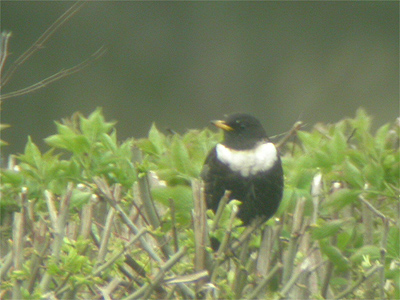 |
|
| .. | ||
| Eakring
and Kersall Ring Ouzel records/accounts The following are accounts of all the area's Ring Ouzel records to date, including the latest 2012 birds. |
||
| .. |
| Near
Eakring Flash - Male April 28 - May 6th 2012 |
||
| A fine male, found along the same hedgerow as the September 2007 bird. For once this was not so flighty and it perched openly on top of the hedge for lengthy periods. Eventually it flew to Lound Wood and was lost from view, but was back at its original location when seen again on April 30th-May 5th. | ||
| Lound Wood/Eakring village - April 21st 2012 | ||
| Heard calling from the Lound Wood, but could not be located at the time. Eventually it flew into gardens at Eakring village, where it was seen to land in an ornamental Willow, before diving into dense cover a short while later. | ||
| Eakring Flash - Male moving north April 7th 2012 | ||
| Picked up moving high north over Eakring Flash and observed to continue north over Lound Wood until lost to view. | ||
| Eakring
village/Red Hill - April 1st 2012 |
||
| Picked up flying low over/out of Eakring village and heading north-west over Red Hill and continuing until out of sight. Some other Midland counties also recorded their first Ring Ouzels the same morning. | ||
| .. | ||
| Penny
Pasture Common/Eakring Meadows - 1st Winter
female October 13th 2010 |
||
| Found in the same location as the Spring bird of 2008, like many of the area's Ring Ouzels, this one was again picked up by call from an area of dense Hawthorn and Blackthorn scrub which divides Penny Pasture Common from the rest of the Eakring Meadows NR. It occurred after a good arrival and southerly passage of Redwings into the UK a few days earlier, when a number of Ring Ouzels had been picked up amongst flocks of Redwings by visible migration enthusiasts at many sites. This bird was definitely not present until October 13th, by which time most Redwings that had been present in the same area of scrub had already moved on. | ||
| .. | ||
| Eakring
village - Female April 19th 2010 |
||
| Occurred on a morning of overcast and rainy conditions, with a light north-easterly breeze, which had seen a small arrival of warblers across the area and the first double-figure count of Swallows passing through. The bird was found whilst checking the horse paddocks for Wheatears at the rear of Ryall's Farm in Eakring. It flew out of an Ivy covered tree into the top of a large Willow, then descended to the hedges around the paddocks, but was flightly and eventually went into dense cover at the rear of some private gardens. | ||
| .. | ||
| Kneesall
- Two 1st Winter females August 27th
2009 |
||
| A most
unexpected find, coming on a day that provided perfect
overnight/early morning conditions for migration, yet
just a handful of Swallows were the only birds noted
during the morning's obligatory visible migration count.
Moving on to Penny Pasture Common, a female Redstart in
the Hawthorns was, at the very least indicative that
migrants were moving, but not a real incentive to look
for much else. The next hour was actually spent searching for invertebrates on Poplars just outside Kneesall and talking to one of the Gamekeepers from the local estate. Walking back to the car, which was parked in a nearby gateway, two 1st Winter female Ring Ouzels flew out of a Mountain Ash, with a single Blackbird following, as I approached. I had no binoculars on me, but the calls of both birds provided as distinctive an ID as one could wish for. Both birds flew into dense cover across the road and although I waited for a further hour, there was no further sign. |
||
| .. | ||
| Penny
Pasture Common/Eakring Meadows - Female
April 19 - 22nd 2008 |
| This bird was found
during an afternoon visit to the area and was initially
in the Hawthorns and scrub, in the north-east corner of
Penny Pasture Common. It was associating with a group of
12 Fieldfare, but eventually left these and appeared to
fly east along The Beck, towards the Kersall end of
Eakring Meadows and was lost from view and not relocated. It was however, present again the following morning and into the afternoon, still in company with 12 Fieldfare and a Redwing. Like several other Spring Ring Ouzels, it was favouring the Ivy covered trees in the area, feeding on Ivy berries. It only showed distantly in the rain when the group descended to feed in nearby fields. This bird occurred when good numbers of Ring Ouzels were at many sites across the Midlands. On April 20th, there were at least six Ring Ouzel at four sites in Nottinghamshire, presumably held up by the bad weather at the time. |
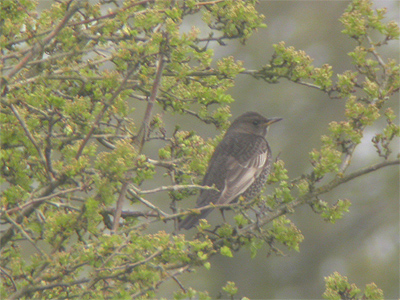 |
|
| .. | ||
| Eakring
Flash - 1st Winter female September 18 - 23rd
2007 |
| Eakring
Flash - Female October 17th 2004 |
||
| The only Autumn record to date (early 2005) and found late afternoon whilst searching for the Great Grey Shrike seen earlier that day at Eakring Flash. It was initially located by call and appeared to be associating with a small number of Blackbirds along the old hedge. Unlike most others, this Ring Ouzel did not fly far when flushed/disturbed and did show well a couple of times until dusk. A search the next day revealed no sign of the bird and it was presumed to have left the area overnight. | ||
| .. | ||
| Eakring
Flash - Male moving north April 14th 2003 |
||
| Quite surprisingly and despite the scarcity of migrant Ring Ouzels, this male flying north over Eakring Flash at 7:57am, was my first ever individual to be recorded visibly on passage in ten years visible migration watching. It was also the first time I had actually heard the flight call and not the more regularly heard "chack" heard by birds on the ground. | ||
| .. | ||
| Tug
Bridge Farm - Male April 1st 2003 |
| This bird was found late
morning (remaining until early afternoon at least) in a
newly cultivated small area of pasture at Tug Bridge Farm
during the first rainy and windy weather since early
March. Presumably this had forced the bird to halt it's
northward progress on this occasion, but a search the
following morning proved fruitless and the bird was
thought to have departed during the night. Adverse weather conditions have not influenced previous records here, with all other birds being found on sunny and relatively windless mornings. It was however the first to show well enough to allow photographs to be taken and indeed, spend any length of time out in the open. Despite a flock of 120 Fieldfare in the general area (at times in the same field) this male showed no association with them, but as most of that flock had also departed next morning, it is possible that the Ring Ouzel could have gone at the same time. |
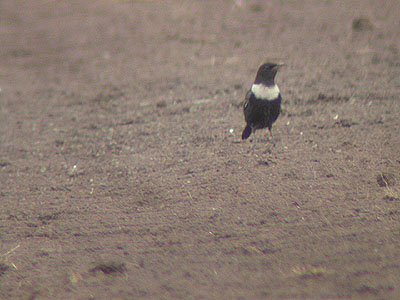 |
|
| .. | ||
| Eakring
village - Male April 16th 2000 |
||
| Found on a beautiful sunny morning, initially sat at the top of an Ash tree adjacent to the Oil Bore Holes site at Eakring village. The bird remained in situ for several minutes, until it descended into dense Hawthorn scrub and was lost from view. | ||
| .. | ||
| Kersall
- Female April 28th 1999 |
||
| On an otherwise quiet morning, this bird was nearly missed. It was it's manner of flight after being flushed from an Ivy-covered tree, then diving into an old Hawthorn hedge near Kersall that alerted me to it being a Ring Ouzel. After a few minutes, the bird (a female) briefly reappeared again, before flying a hundred or so yards into some large Willows near The Beck. News of the bird was immediately put onto the Nottinghamshire Bird News service and was still reported as present later the same day. | ||
| .. | ||
| Eakring
Flash - Male April 22nd 1998 |
||
| After an excellent morning on which numerous Summer migrants arrived, a further mid-afternoon visit produced a male Ring Ouzel. The bird was noted almost as soon as I had got out of the car, flying past me from the pastures area and heading towards Eakring Flash. It was seen to alight in an Ivy-covered tree and begin feeding, but was disturbed and flew further away and was lost from view. | ||
| .. | ||
| Leyfields
Farm - Male April 20th 1997 |
||
| This bird was pulled out of a mist net operated by Andy Chick at Leyfields Farm, Eakring. As far as I know, this is the only Ring Ouzel to be trapped and rung in Nottinghamshire. | ||
| Comparison of Spring and Autumn Ring Ouzel records in Nottinghamshire and at Eakring | ||
| .. | ||
| The graph in Fig 1
depicts all Nottinghamshire Ring Ouzel records dating to
Spring 2003, with all Eakring records occuring within
that time shown in blue. It is clear that April is the best month for Ring Ouzel's to turn up in Nottinghamshire. A general peak occurs between April 20-29th, a period that usually coincides with peak numbers of Wheatears moving through the area. The two birds at Eakring in 2003, continued a relatively regular series of records here by this uncommon Nottinghamshire migrant. Since a male was rung at Leyfields by Andy Chick (see photograph) in April 1997, a further six Spring records have occurred - four of which have been males. There is a tendency for males to arrive slightly earlier than females and this is shown in Fig 2. Most of the county's late March and early April records are of males, and females have generally arrived in conjunction with the peak numbers of Spring records. |
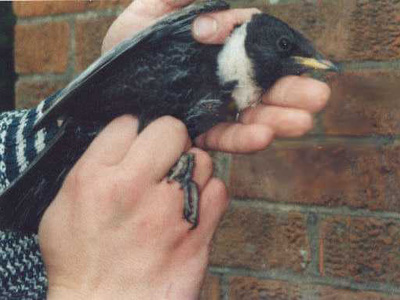 |
|
| .. | ||
| Fig 1. Spring Ring Ouzel occurrences in Nottinghamshire .. Historical records to 2003 | ||
| .. | ||
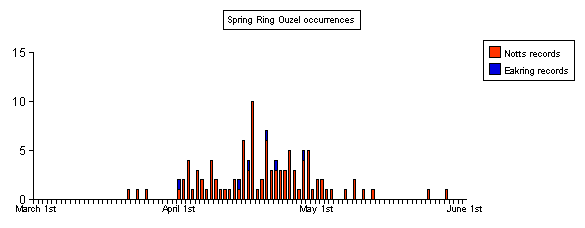 |
Out of all the county's historical Ring Ouzel records, only 94 have had their sex accurately determined and of these some 71% have been males. Clearly this must be a species which passes unnoticed at many sites, through it's generally shy and extremely wary nature and it would seem that as in the case of Wheatears and other chats, Ring Ouzels can turn up just about anywhere and in a multitude of habitats. Birds have most often been found near Hawthorn (either scrub or hedgerow) and there have been two which showed a preference for Ivy-covered trees. |
|
| .. | ||
| Fig 2. Comparison of Spring records of male and female Ring Ouzels in Nottinghamshire .. Historical records to 2003 | ||
| .. |
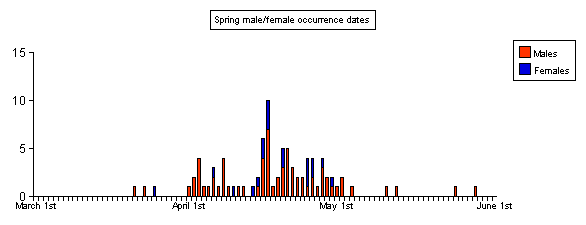 |
Up until 2003, Ring Ouzel occurrences at Eakring were restricted to a 13 day period from the middle of April onwards, a general trend which fits in well with that of Wheatear arrivals - another early arriving migrant. Although Ring Ouzels do turn up across the Midlands in late March, it has yet to do so here, although the date of the Tug Bridge Farm bird (April 1st) virtually falls within the late March limits. Even records from the whole of Nottinghamshire are sparse during March, but they are seen in conjunction with Wheatears in Pennine areas at this time. | |
| .. | ||
| Fig 3. Autumn Ring Ouzel records in Nottinghamshire .. Historical records to 2003 | ||
| .. | ||
| Autumn Ring Ouzel records have remained sparse. Despite much searching each year since 1998, there were no Autumn records from the area until a female was eventually found with a small group of Blackbirds along the old hedge at Eakring Flash on October 17th 2004. This date fitted in reasonably well with all previous (pre-2000) Nottinghamshire records dating back to the 1800's. A clear Autumn peak occurs during the first week of October. Ring Ouzels have proved to be much rarer in Nottinghamshire during the Autumn. | 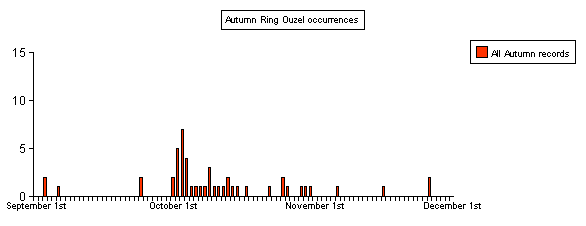 |
|
| .. | ||
| Two of the four Eakring Autumn records here, have shown that there is possibly a tendency for Autumn migrants to loosely associate more with Blackbirds than other migrant thrushes. Birds found by Paul Naylor and myself in the Maun Valley and at King's Mill Reservoir, certainly fit that criteria and although birds do arrive along the UK's east coast in conjunction with the mass arrivals of Redwing and Fieldfare, until recently it seemed that there was little direct association with these species' in their Autumn occurrences in Nottinghamshire. However in early October 2010, Ring Ouzels were recorded on many occasions in with migrating Redwing flocks that had arrived fresh from the continent. | ||